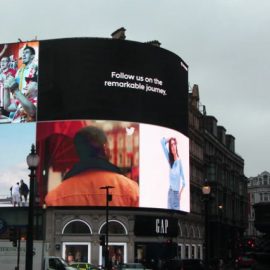

This article is an excerpt from the Shortform book guide to "Loonshots" by Safi Bahcall. Shortform has the world's best summaries and analyses of books you should be reading.
Like this article? Sign up for a free trial here .
What is the meaning of “loonshots”? What are some examples of loonshot ideas?
Loonshots are ideas that are so original and ambitious that they and their creators are initially dismissed as crazy (e.g. radar, insulin, computer animation). Loonshots begin as flawed, incredibly fragile ideas that almost don’t make it, which is why they require special care.
Here’s why loonshots are so fragile as well as why organizations tend to leave loonshots behind as they grow.
The 2 Types of Loonshots
Bahcall explains that loonshots come in two varieties: product loonshots and strategy loonshots.
Product loonshots are new inventions or new technologies. For example, Karl Benz’s Patent-Motorwagen is a product innovation. Though others had experimented with self-propelled carriages before, Benz engineered what is generally considered the first practical modern automobile.
Strategy loonshots are new ways of doing business or of tackling a problem. For instance, Ford’s assembly-line production of the Model-T is a strategic innovation. Henry Ford invented neither cars nor the conveyor belt. But by combining the two to massively cut production times and manpower, he created a way to mass produce cars that were consistent and, crucially, affordable to the general public.
Bahcall stresses the importance of paying attention to both types of loonshots. Both types are capable of upending an industry (or creating an entirely new industry). As we’ll see later in this guide, if you focus on only one type of loonshot, you might develop a blindspot that lets a competitor overtake you.
Loonshots Are Fragile
A key characteristic of loonshots is their fragility. Bahcall points out that loonshots die multiple deaths before finally succeeding. Bahcall calls this the “three deaths” (though he notes there may be more than three) and says this cycle can go on for years, even decades. (Shortform note: Bahcall’s description of the three deaths reflects the widely accepted observation that failure is a crucial part of the creative process and an unavoidable element of any business. In Designing Your Life, Bill Burnett and Dave Evans recommend becoming immune to failure, by which they mean that you should try to fail more often, because doing so requires taking creative risks that you can learn from.)
To illustrate the typical early stages of loonshot development, Bahcall gives the example of Akira Endo, who discovered statins, a class of drug that prevents heart attacks and strokes by lowering blood cholesterol. Endo’s idea died three times before its ultimate success:
- Endo’s ideas were initially rejected because previously developed cholesterol-lowering drugs were more harmful than helpful.
- When Endo first tested his drug on rats, it had no effect. He eventually discovered that rats have naturally low levels of bad cholesterol. When Endo tried the same drug on chickens (which have higher levels of bad cholesterol), it worked.
- Endo’s research was finally shut down after a study appeared to show that statins caused cancer in dogs.
Meanwhile, Bahcall says, pharmaceutical company Merck borrowed Endo’s research to create their own statin, and when the dog study proved to be flawed, they marketed one of the most successful pharmaceuticals in history.
Growing Pains
In Endo’s case, none of these deaths reflected an actual problem with his idea. But other times, there are good reasons why loonshots fail at first. Bahcall points out that loonshots tend to begin life with a lot of flaws, and that early-stage loonshots often look very different from the final, successful ideas that they become.
To demonstrate the growing pains that many loonshots go through, Bahcall gives the example of Dr. No, the first James Bond movie. The original script featured an evil monkey as the villain. Studios found this idea silly, and the script was rewritten before the movie went into production.
(Shortform note: It’s not always easy to tell which aspects of an idea are flaws and which aren’t. As Bahcall notes, the big studios rejected the monkey, but they also argued that American audiences would never go for a British hero, and they hated the then-unknown actor proposed for the lead role—that actor, of course, was Sean Connery. With the benefit of hindsight, it’s easy to see that they were right about the monkey and wrong about the rest. But at the time, could anyone have predicted 24 Bond sequels (as of 2022) or a movie-star career for Connery? Prediction is hard, a fact that makes it even harder to assess early-stage loonshots.)
Loonshots Require Persistence and Patience
Because loonshots are fragile, especially in their early stages, Bahcall emphasizes the importance of not giving up on them. As noted above, loonshots usually start off with flaws, and you should expect early failures.
Moreover, he points out that not all deaths are true deaths. Endo’s rat trials failed not because the drug was flawed, but because the test was flawed. (Shortform note: Plus, some deaths have nothing to do with the idea’s merit. The medical establishment was shortsighted in rejecting Endo’s ideas out of hand, and the big studios were wrong in their predictions about Bond’s commercial appeal.)
Loonshots Evolve Into Franchises
Another important characteristic of loonshots is that they are distinct from what Bahcall calls franchises. A loonshot is an innovative new idea. A franchise is the steady, reliable growth and incremental improvement of an established idea. Bahcall gives the example of film franchises, and we can also think of fast food franchises. When an organization is in the franchise phase, it iterates on an established product and follows a predetermined business plan.
| Does “Loonshots” Mean the Same Thing as “Disruptions”? The concept of loonshots and the dichotomy between loonshots and franchises is reminiscent of ideas from a number of other business and technology writers. Perhaps the most familiar parallel to the loonshot/franchise model is Clayton Christensen’s theory of disruptive innovations and sustaining innovations. According to Christensen, sustaining innovations are those that provide incremental improvement to an already-existing market, whereas disruptive innovations fundamentally change the market or open up a new one. Bahcall is careful to point out that the two types of loonshots (product and strategic) don’t correspond to this earlier idea of sustaining and disruptive innovations, and that’s a fair point. But he also dismisses the idea of disruptive innovation as a whole, arguing that not all disruptive technologies follow the market trajectories that Christensen describes and that you can’t always predict which innovations are going to be disruptive. His ultimate stance is that businesses shouldn’t build their strategies around trying to be disruptive because that is too nebulous and uncertain a goal. Instead, he argues that his loonshot rules let businesses innovate by challenging their ingrained habits and beliefs. Despite Bahcall’s objections, there is a parallel between the loonshot/franchise model and the disruptive/sustaining model. If anything, we might see Bahcall as adding an important nuance to disruption theory. Whereas Christensen is concerned with how some businesses sustain markets until others disrupt them, Bahcall describes how both loonshot practices and franchise practices can exist within the same business. Furthermore, Bahcall suggests that loonshot and franchise practices can exist in steady symbiosis in some industries, rather than in the cycle of status quo-disruption-status quo that Christensen describes. For instance, Bahcall explains that the pharmaceutical industry depends on an ongoing relationship between small, innovative biotech startups who develop new drugs and the large pharmaceutical corporations who eventually market the finished products. |
Bahcall points out that a loonshot can evolve into a franchise. This happens when a business begins with an original creative idea (the loonshot) which eventually solidifies into a consistent business plan, development cycle, and so on (the franchise phase). To return to the example of Ford, after the strategic innovation of assembly line methods, the company shifted to the franchise phase, focusing on consistent production cycles and gradual development of their vehicles rather than constant dramatic innovation.
A final, crucial observation Bahcall makes is that both loonshots and franchises can exist within the same organization. He argues that by following his four rules, an organization can remain innovative at any size. (Shortform note: In contrast, it’s practically a business cliché that startups and small companies are nimble and innovative whereas big companies are steady but inflexible. That’s why so many business books focus on how to break a new idea into the mainstream or how to keep innovating once you’ve grown.)

———End of Preview———
Like what you just read? Read the rest of the world's best book summary and analysis of Safi Bahcall's "Loonshots" at Shortform .
Here's what you'll find in our full Loonshots summary :
- How some of the world's biggest inventions started as "loonshots," or crazy ideas
- The four rules for nurturing a loonshot
- How organizations can keep innovating no matter how big they grow






